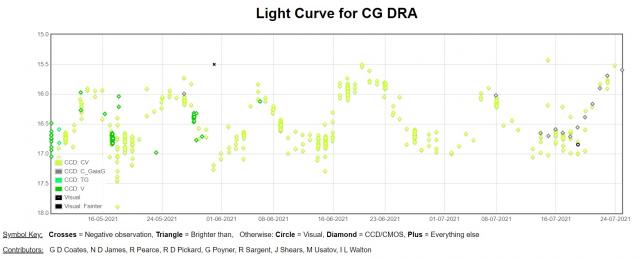› Forums › Variable Stars › CG Dra: a VSS campaign
- This topic has 195 replies, 9 voices, and was last updated 9 months, 2 weeks ago by
 Jeremy Shears.
Jeremy Shears.
-
AuthorPosts
-
20 July 2021 at 3:22 pm #584490
 Jeremy ShearsParticipant
Jeremy ShearsParticipantGood to see the data rolling in for this star. Many thanks to all observers. It’s been faint for a few days: I’ve have it at 16.6 yo 16.7 the last couple of nights.
Now the nights are getting a bit longer, some time-series photometry runs become possible.
25 July 2021 at 5:28 pm #584508 Jeremy ShearsParticipant
Jeremy ShearsParticipantCurrently in outburst.
 28 July 2021 at 6:50 pm #584534
28 July 2021 at 6:50 pm #584534 Stewart John BeanParticipant
Stewart John BeanParticipantI am occasionally contributing to the present campaign on CG Dra with a V filter on iTEL 18 in Spain. Many of the results are being gathered using the CV method.
What systematic differences do we expect between the two?
Stewart
28 July 2021 at 9:49 pm #584536 Jeremy ShearsParticipant
Jeremy ShearsParticipantLooking at the light curve Stewart, there is not much difference. In any case, the objective of the project is to measure the time and duration of each outburst, rather than its precise mag. Thanks for your observation. If you are getting decent signal to noise ratio then stick with the V filter -after all, you are using a decent aperture scope. But no filter allows better SNR, so is often preferable with small telescopes.
30 July 2021 at 1:18 am #584547 Dr Paul LeylandParticipant
Dr Paul LeylandParticipantNights are moderately long (though dusty and/or smoky) in these parts.
The orbital period of 0.18864 days according to AAVSO appears well determined. What is the value of further lengthy observation runs? Is there a suggestion that the period may be changing or are we looking for flickering in the accretion disk?
I am prepared to spend some telescope time if it is worth my while but there other calls on it too.
(Added in edit: not that it makes any difference tonight. Complete cloud cover as of about 45 minutes ago.)
30 July 2021 at 9:44 am #584548 Jeremy ShearsParticipant
Jeremy ShearsParticipantOur earlier work suspectEd shallow eclipses. Can we confirm and does the depth vary with outburst status (outburst vs quiescence)?
22 October 2021 at 4:05 pm #584826 Stewart John BeanParticipant
Stewart John BeanParticipantGot a few images now from the AAVSOnet SRO telescope in the USA on CG Dra. It has been down for some time.
Hopefully more will follow.
Stewart
10 May 2022 at 3:40 pm #610206 Maxim UsatovParticipant
Maxim UsatovParticipantHad a run on CG Dra tonight.
Attachments:
11 May 2022 at 1:34 am #610235 Jeremy ShearsParticipant
Jeremy ShearsParticipantThanks Max. There’s a lot of variation there. Not sure it’s regular though. Time will tell.
Keep up the good work!Go well!
Jeremy11 May 2022 at 12:18 pm #610236 Maxim UsatovParticipant
Maxim UsatovParticipantThanks, Jeremy! With tonight data..
Attachments:
13 May 2022 at 1:56 pm #610309 Maxim UsatovParticipant13 May 2022 at 5:32 pm #610313
Maxim UsatovParticipant13 May 2022 at 5:32 pm #610313 Jeremy ShearsParticipant
Jeremy ShearsParticipantThanks Max. When I have a moment I’ll put it through Peranso to see if there are any signals.
16 May 2022 at 12:47 pm #610330 Maxim UsatovParticipant
Maxim UsatovParticipantLooks like it’s in outburst.
Attachments:
16 May 2022 at 2:39 pm #610332 Jeremy ShearsParticipant
Jeremy ShearsParticipantYes, mag is certainly consistent with an outburst Max
16 May 2022 at 6:11 pm #610333 Maxim UsatovParticipant
Maxim UsatovParticipantGot some interesting result on the data collected. Although probably spurious, the period is really close to the 6h 22m +/- 26 m period for a matching K5 main sequence star mentioned in Bruch et al. (1997). I’ve never used FALC before, so not sure if this power is of any significance, likely not?
Max
Attachments:
17 May 2022 at 11:35 am #610337 Maxim UsatovParticipant
Maxim UsatovParticipantToday CG Dra was at it’s brightest ever recorded during the past 2 years.
-
This reply was modified 1 year, 11 months ago by
 Maxim Usatov.
Maxim Usatov.
Attachments:
17 May 2022 at 12:25 pm #610344 Maxim UsatovParticipant
Maxim UsatovParticipantSorry for double posting, it looks like I only have limited time available to edit my previous post. The 6-h period disappeared with today’s data, so it was spurious and likely me not understanding how to use FALC. I now realize it requires manual manipulation with light curve segments to bring them down to the same magnitude level, so I dropped this idea. With today’s data, I have fitted a high-degree polynomial to “detrend” data assuming eclipses also occur in the outburst state, and many algorithms converge on a 4.52-h period appearing in the residuals. Although, still, more observations are obviously needed. I also wonder if I should search eclipses in the quiescent data only.
Max
Attachments:
18 May 2022 at 4:52 pm #610350 Jeremy ShearsParticipant
Jeremy ShearsParticipantWorth looking for quiescence eclipses, Max. Accretion disc might be smaller then and thus more easily eclipsed
22 May 2022 at 7:47 am #610436 Maxim UsatovParticipant
Maxim UsatovParticipant30 s resolution, CV mode.
Attachments:
23 May 2022 at 11:32 pm #610451 Maxim UsatovParticipant
Maxim UsatovParticipantAnother run with 30 s resolution. Refined ensemble selection and added visual ensemble/check star control – much better precision, albeit the seeing was pretty bad and clouds began to appear in the middle and near the end of the run. The routine handled the situations well. Hopefully fully prepared to try to catch those eclipses.
Attachments:
-
AuthorPosts
- You must be logged in to reply to this topic.










